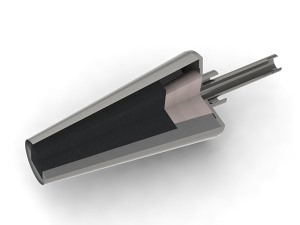Precautions for impermeable breathable bricks
The essence outside the furnace has become an important part of the modern steelmaking process, and the argon blowing at the bottom of the ladle is an important part of the essence outside the furnace, and the ladle breathable brick is the key component to complete this process, and steel manufacturers pay special attention to it. Good breathable bricks It should have the characteristics of long service life, good bottom blowing effect, no (less) purging, safety and reliability. The current ventilation bricks mainly include slit type and anti-seepage type. The width and distribution method of the slit of the slit type ventilation brick must be Reasonable planning is carried out according to the ladle capacity, smelting steel type and the required air permeability, so the production process is more complicated; the anti-seepage type air brick produces many irregularly distributed through holes by controlling the particle size ratio of the ingredients, and its production process Relatively brief.
The anti-seepage type ventilation brick adopts the structure of a combination of a breathable inner core and a fine high-strength material: the working range of the brick core is part of the anti-seepage type design, and the Anxian equipment adopts a slit type design. If the residual height of the bricks is insufficient, the ventilation bricks need to be replaced.
In the process of transportation and installation of the breathable brick, it is necessary to ensure that the thread of the steel pipe at the end is not damaged, so as to avoid the loose connection of the pipeline and air leakage, which will affect the flow rate and blowing rate of argon blowing; ensure that the tail steel pipe does not enter dust and debris; The working surface should not be covered by fire mud or other materials to avoid unsuccessful bottom blowing. During the installation or use process, ensure that the pipelines are connected tightly without air leakage, otherwise the argon pressure will be insufficient, which will affect the stirring effect and cause the blowing rate to drop. .
If the alloy is added too early when the converter is tapping, and the molten steel level in the ladle is too low, the low melting point of the alloy with strong permeability will simply lead to poor permeability of the brick core. If the argon operation is not standardized, and the argon gas is not turned on in time to stir after tapping, it is easy to cause the essence to be difficult to blow in the early stage.
The bottom of the cladding is severely crusted, there are many online turnover ladles, the slag can be poured in time after the steel pouring, the hot repair does not blow the breathable brick, the ladle hot stop time is long, and the molten steel tapping temperature is one level lower, which is easy to cause the appearance of the brick core. There are residual molten steel and steel slag, and the surface is easy to crust and affect the ventilation function.

Previous: The role of coil glue
下一条: Factors affecting the ventilation function of ventilation bricks
Related Industry Knowledge
- Features and Benefits of Coil Clay
- What are the advantages of a good furnace lining
- Misunderstandings in the use of ramming materials in intermediate frequency furnaces
- Phenomenon analysis of failure of argon blowing of ladle permeable bricks and how to improve the rate of argon blowing
- Where is the consumption reduction and energy saving of breathable bricks reflected?
- How to improve the service life of intermediate frequency furnace lining
- Reasons for damage to intermediate frequency furnace lining and how to solve them
- The performance and advantages of breathable brick
- Analysis of Structural Characteristics of Dispersive Breathable Bricks
- The intermediate frequency furnace charge knotting process needs to pay attention to details sharing
- The role of coil glue
- Talking about the construction technology of dry ramming material
- The composition and function of ramming material
- Introduction of Insulation of Coil Clay
- Safety elements of ladle breathable bricks


